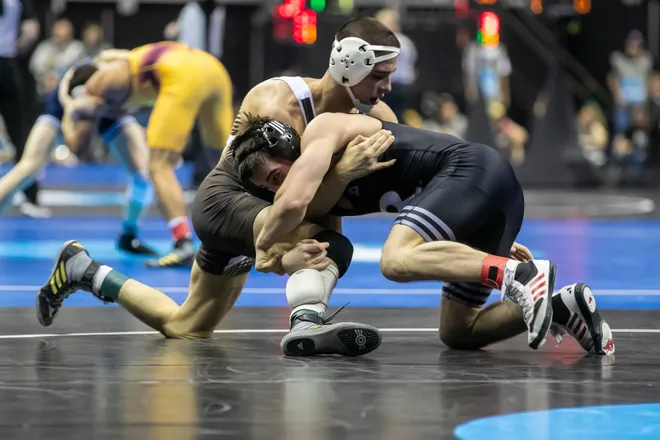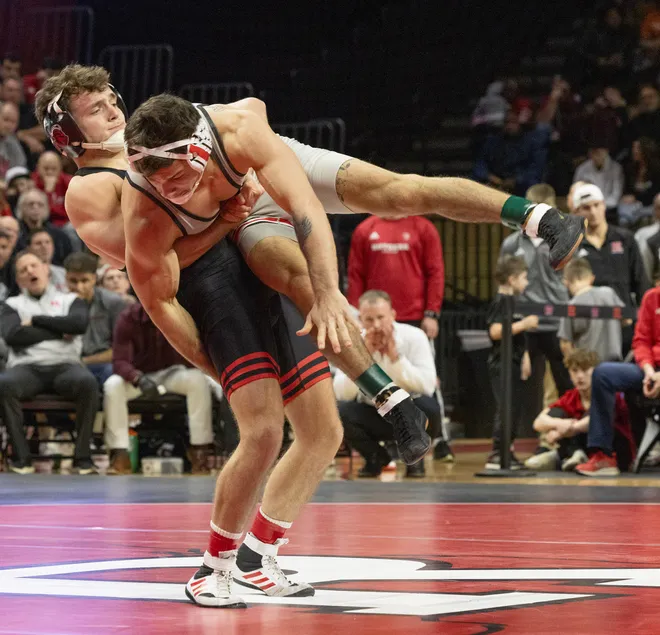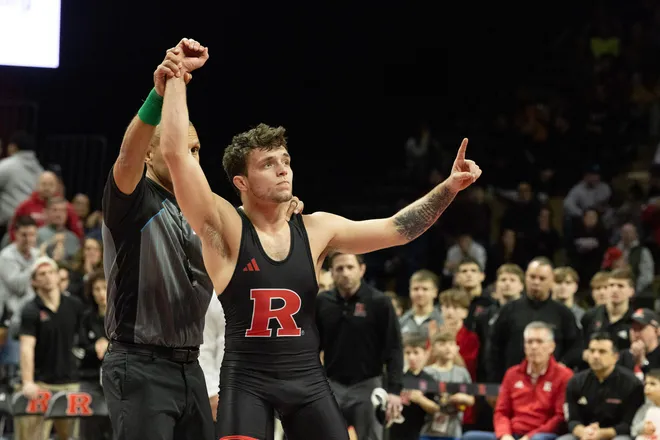Is there a safe way to 'make weight' as a high school wrestler? Here's what experts say
University of Iowa men’s wrestlers awoke around 6 a.m. on Thursday in Kansas City, Missouri, to prepare for their weigh-ins that morning. They got on a scale to see where they stood. Some of them worked out, but it was only to take off a half-pound or pound. Some of them even had a snack.
These last two visuals, supplied by Dr. Andy Peterson, their team physician who was with them at last weekend's NCAA Division I championships, might give you pause if you were a wrestler in the 1980s and 1990s. When you conjure up images of the sport, and how you prepared to “make weight,” you might see yourself, or your high school teammates, running or working out under several layers of clothes or a rubber suit to sweat off the pounds. Or eating little, or nothing, for days. Or practicing while you were heavily dehydrated.
Such tactics, now universally recognized as unsafe, were once a part of the sport. The story of fictional Louden Swain in the 1985 movie "Vision Quest," who dropped down two weight classes in one season, became a ballad for a generation of wrestlers about the sweat and sacrifice elite wrestlers endured.
COACH STEVE: When can teens start lifting weights and have a personal trainer and coach?
Today, hydration and nourishment leading up to weigh-ins are crucial components to wrestling success. There are limitations at the high school and collegiate levels on how much weight wrestlers can lose and minimum body fat levels they must maintain.
Colleges and high school wrestlers weigh in 1 to 2 hours before matches. They continue to be educated about how dropping a significant number of pounds in water weight right beforehand is not only dangerous, but puts them at a distinct competitive disadvantage.
“We try to make it clear what the top athletes are doing,” says Peterson, who takes care of Division I men’s and women’s wrestlers at Iowa and Olympic-level wrestlers. He specializes in pediatrics and sports medicine. “The top athletes maintain the weight pretty well year-round. They're not using rapid weight reduction practices. They're definitely not stepping on the scale under-fueled or underhydrated.
"So some of this is leading by example."
USA TODAY Sports spoke with Dr. Peterson, as well Tasha Taveras, a dietician who works with wrestlers at Rutgers, and Rob Marshall, vice president of the National Athletic Trainers' Association (NATA), about how parents can safely navigate the sport and the weight loss that remains part of its culture.

1. Weight-cutting in wresting: Understand the rules and the risks
According to NCAA rules, collegiate wrestlers can’t lose more than 1.5% of their weight per week. The same policy is recommended by the NATA and followed by state high school associations.
College programs perform body composition scans and have a team of doctors and athletic trainers to monitor overall health.
For the 300,000-plus high schoolers who wrestle, though, the onus of health and safety falls on the athlete and the family.
“The general rule of thumb is that you want to do as little weight cutting as possible when you're younger," Peterson says. “Most of those guys are still developing. Most still have muscle mass to put on, still going through puberty, and you can stunt those things by restricting calories, especially early on.”
The idea is to compete at your optimal weight for success but also at a weight where you are comfortable. In some cases, it might make sense to wrestle "up" so you don't have to worry about weight loss.
"If you're a very talented (high school) kid whose natural weight is 140 pounds, it doesn't make any sense for you to cut down to 130 pounds for a very small competitive advantage," says Peterson, who is also a former high school and collegiate wrestler.
Before Marshall became VP of the NATA, he was a child wrestler, too. He's now been an athletic trainer for 28 years and works with high school wrestlers in Columbus, Nebraska, through the city's community hospital. He helps young wrestlers understand healthy diet and how minimal weight loss brought on by the rigors of practice can improve your overall health and increase your performance on the mat.
His lessons, he has found, are also instructive to former wrestlers.
"Old wrestlers raise young wrestlers," Marshall says. "So, a lot of times, you’ll have some of those less-healthy habits that get carried down from generation to generation. … They were remarkably stunned how much they can actually eat and still maintain that healthy weight and weight loss at 1.5% per week.
“When I grew up, I spent more time focused on weight loss and making weight than I did on practice. That didn't get us anywhere. If the whole idea is to take a young person and teach them the sport and then let them progress and get better in it, if you spent your whole time dealing with practice with weight loss, you didn't get any better."
The NCAA’s minimum body fat percentage requirements are 5% for men and 12% for women. The general rule high school wrestlers follow is a minimum 7% body fat percentage for boys 14% for girls, Peterson says.
“There is a real question about if that is high enough for women,” Peterson says. “For guys, I think most people think that's reasonably safe. For the women, there's some question. There's a lot of variability in what 12% body fat looks like on a woman. We're probably putting some athletes at risk for female athlete triad, which is now called relative energy deficiency in sports.
“We worry a lot about the female wrestler loses their menstrual period and what their long-term effects in their bone health and things like that could be.”
Two pieces of advice:
- Consult your pediatrician, and speak to your school’s athletic trainer if you have one, about a healthy diet, weight and body fat percentage for your wrestler.
- And if you're looking for an offseason environment where wrestlers focus on technique, and not weight loss, inquire within your community about club wrestling.
"Most people want to be reasonably lean, but they don't want to impair their health and performance by being excessive in their calorie counting," Peterson says.
2. Dehydration in wrestling: It impedes your development and is dangerous to your health
Since actor Matthew Modine portrayed a wrestler who cut significant weight to wrestle as a 168-pounder in "Vision Quest," the sport has been rocked by scandal. Three collegiate wrestlers died trying to reach their target weights in 1997 through dehydration tactics.
Intercollegiate wrestling re-emerged in early 1998 with rules that barred wrestlers from using vapor-impermeable suits, saunas, diuretics and other practices of losing weight.
Today, by NCAA rule, weigh-ins are held 1 to 2 hours before matches. Before the rule change, wrestlers weighed in five hours before dual meets and the day before tournaments. They could dehydrate themselves to reach their target weight and then had those longer period of time to rehydrate and recover.
The sport is difficult enough without those practices. Taveras, who closely monitors the hydration and nutrition at Rutgers, says her men’s wrestlers can lose 3% to 5% of their weight class in one workout if they are dehydrated. For every pound they lose, she advises them to drink 20 ounces of fluid.

It’s still common, Peterson says, for wrestlers to train in warm environments. NCAA wrestling rooms can't be warmer than 80 degrees, but wrestlers wear sweats to improve their heat tolerance and muscle elasticity and to promote a high sweat rate.
"We want them to be able to cool very efficiently and we want them to be able to take off a little bit of weight quickly when they need to," he says.
But, he says overall weight loss should be gradual and wrestlers should only take off a pound or two right before weigh-ins. Severe dehydration can put wrestlers at risk for acute kidney injury and thrombotic events.
Dehydrating yourself also affects how you fare in matches.
“There's pretty good evidence that dehydration of more than 2% of body weight impairs performance,” Peterson says. “So no one in their right mind would be taking off more than that in their body weight when they don't have time to replenish that.”
MORE COACH STEVE:How much is too much working out for a young athlete's body to take?
3. 'Have a good relationship with food': Here's what to eat to help your wrestling performance and to stay healthy
Marshall surprises high school wrestlers and their parents when he instructs them to eat before practice.
“You want to fuel that kid up so that he actually can practice hard and burn the calories, not the sweat," he says.
There are strategies to cut a small amount of weight while replenishing yourself as you work toward your weigh-in. Here's what Peterson recommends:
- Three of four days out, start limiting fiber in your diet.
- A couple days out, start limiting salt in your diet.
- A day or so out, start limiting the "really high glycemic index stuff" because you're not really replacing your high-glycemic-index food needs until after weigh-ins.
Peterson explained those three categories hold onto water in your body, and working off one or two pounds before weigh-in is OK. But remember that after you weigh in, you'll be staring at an opponent who has trained as hard as you and wants to put you on your back. It's essential to be properly fueled.
That's why wrestlers at both Iowa and Rutgers try to get in high-glycemic-index calories right after weigh-in and before the match:
“For performance for athletes that are burning so much energy a day … the quickest form of energy is sugar,” Taveras says. “Your body's gonna break it down right away.”
Taveras, who also worked with wrestlers during a fellowship at the University of Michigan, offers a variety of forms of these calories to the wrestlers at Rutgers. Here are some snacks they like to eat:
- Fruit and fruit snacks
- Moderately sized deli sandwiches
- Peanut butter and jelly with white bread
- Yogurt (but not Greek yogurt)
- Applesauce
- Pancakes.
- Chicken noodle soup with Goldfish crackers
That last one is a Rutgers team favorite. Fluids with salt and sugar get absorbed quickly, which is what you want.
“A lot of times, they're cold,” Taveras says, “so a cup of soup is just quite nice. They love the noodles. They steal all the noodles from each other."

Just remember: Don't eat too much. The idea is to practice overall health and well-being on a day-to-day basis. It has become an important theme in the sport over the last two and a half decades.
Taveras said it takes a lot of education and reinforcement during the offseason, too, so wrestlers feel confident and comfortable eating a good amount throughout the season.
“It is just the culture of wrestling to (say), ‘What do you mean I can eat a sandwich and then wrestle? I can eat and still lose weight?’" Taveras says. "I'm not putting bad terms on food. So they're not feeling like, 'Oh, I'm so restricted. I have to go binge. I'm gonna eat all this bad food, and then I'm gonna kind of restrict for the week.'
"If you're wrestling your whole life from age 6 to 24, that's a very long time. And I want to make sure that when they're done with the sport they have a good relationship with food. So, I'm kind of thinking long term with them.”
Steve Borelli, aka Coach Steve, has been an editor and writer with USA TODAY since 1999. He spent 10 years coaching his two sons’ baseball and basketball teams. He and his wife, Colleen, are now sports parents for a high schooler and middle schooler. His column is posted weekly. For his past columns, click here.
Got a question for Coach Steve you want answered in a column? Email him at sborelli@usatoday.com
Disclaimer: The copyright of this article belongs to the original author. Reposting this article is solely for the purpose of information dissemination and does not constitute any investment advice. If there is any infringement, please contact us immediately. We will make corrections or deletions as necessary. Thank you.







